Analyzing Demand and Supply in Contemporary Business Economics
VerifiedAdded on 2022/12/30
|10
|2026
|46
Report
AI Summary
This report provides an in-depth analysis of the laws of demand and supply within the context of contemporary business economics. It begins by defining economics and its two main branches, macro and microeconomics. The report then delves into the law of demand, explaining its inverse relationship with price and illustrating movements along and changes in the demand curve, along with the factors affecting the curve shifts, such as consumer income, tastes, and prices of related goods. The law of supply is then discussed, highlighting its positive relationship with price. The report also examines movements along the supply curve and factors that cause shifts in the supply curve, like input costs and technology. The report concludes by emphasizing the importance of demand and supply models in making pricing decisions and understanding how changes in these forces can affect a company's operations. The assignment, contributed by a student, is available on Desklib, a platform offering AI-based study tools.
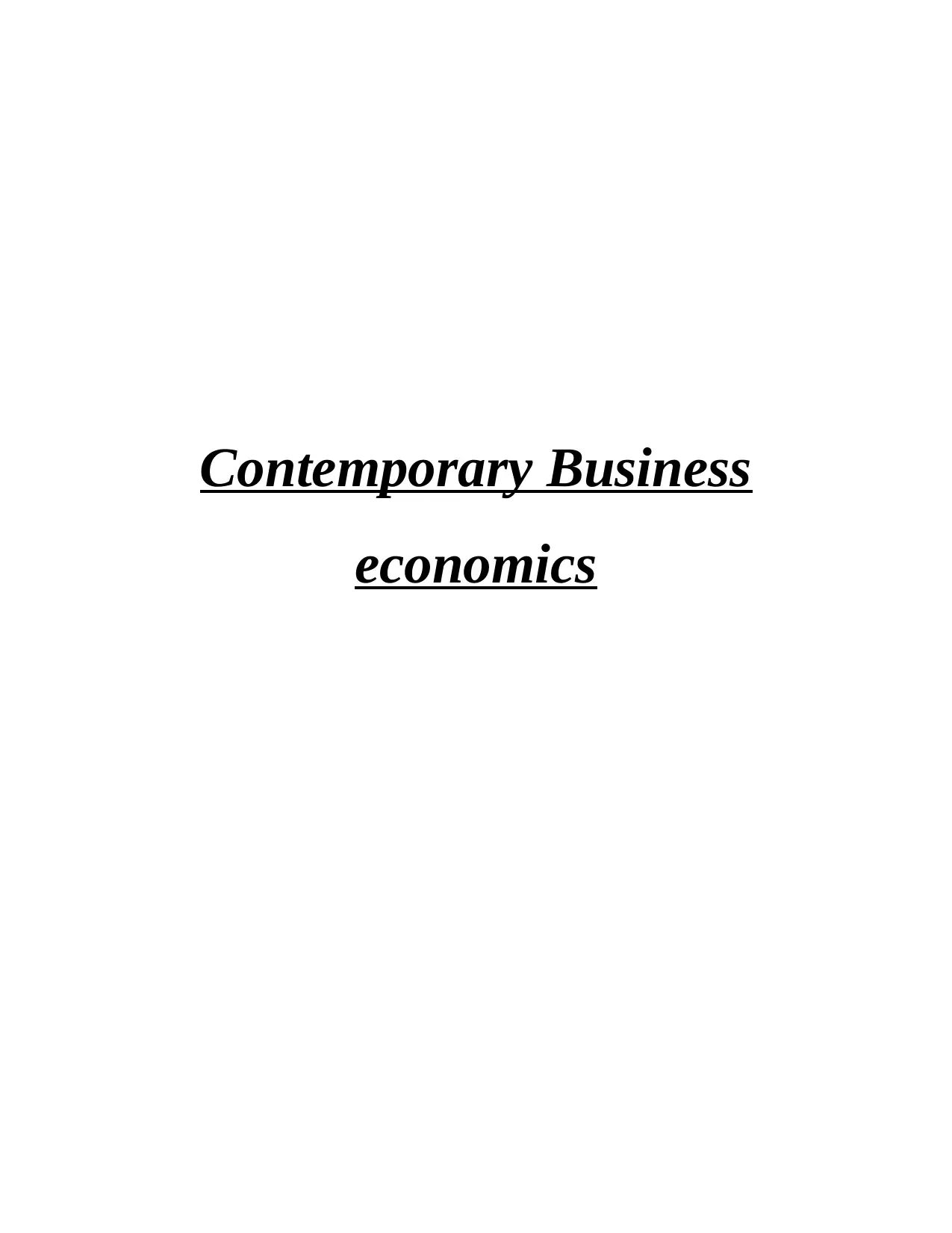
Contemporary Business
economics
economics
Paraphrase This Document
Need a fresh take? Get an instant paraphrase of this document with our AI Paraphraser
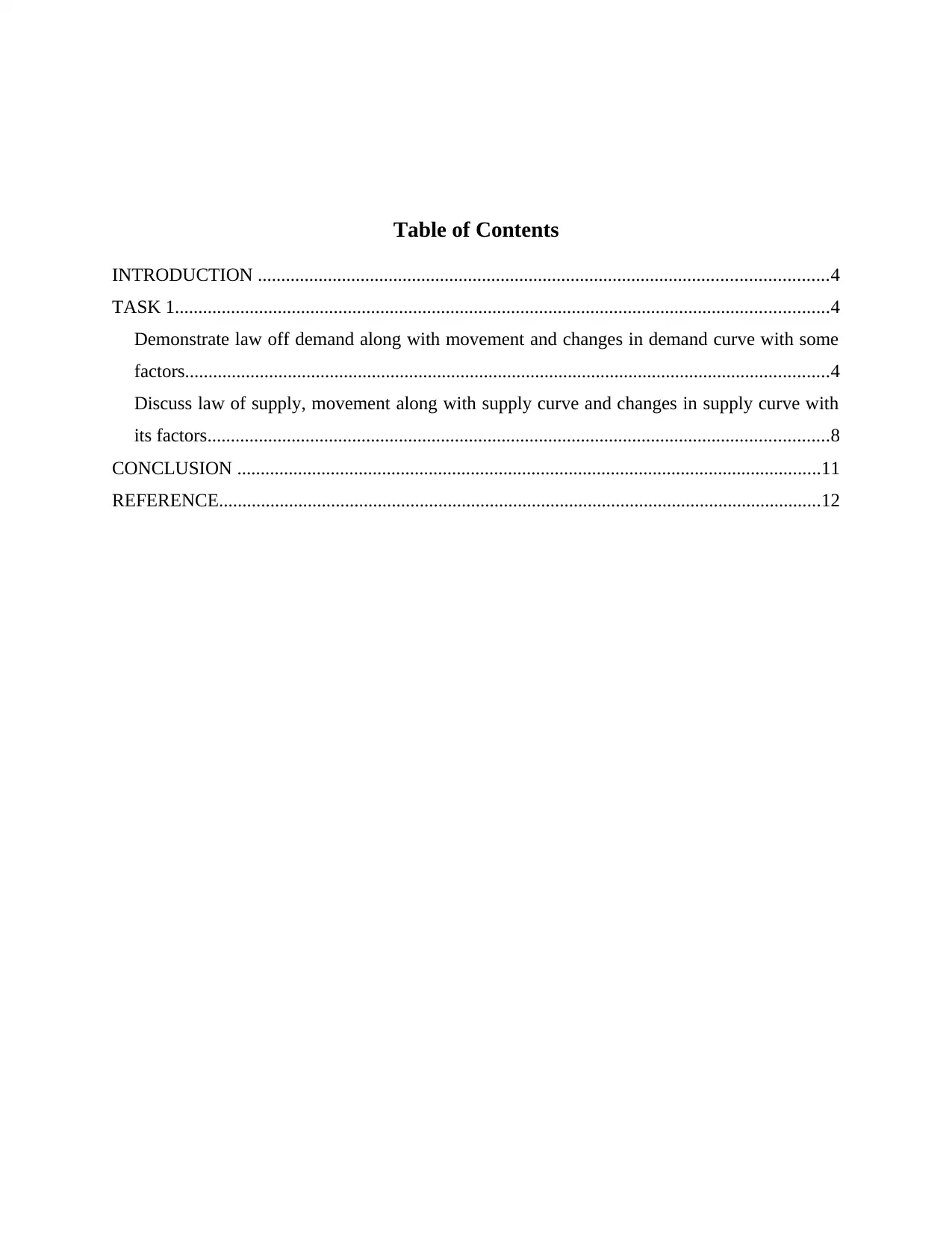
Table of Contents
INTRODUCTION ..........................................................................................................................4
TASK 1............................................................................................................................................4
Demonstrate law off demand along with movement and changes in demand curve with some
factors..........................................................................................................................................4
Discuss law of supply, movement along with supply curve and changes in supply curve with
its factors.....................................................................................................................................8
CONCLUSION .............................................................................................................................11
REFERENCE.................................................................................................................................12
INTRODUCTION ..........................................................................................................................4
TASK 1............................................................................................................................................4
Demonstrate law off demand along with movement and changes in demand curve with some
factors..........................................................................................................................................4
Discuss law of supply, movement along with supply curve and changes in supply curve with
its factors.....................................................................................................................................8
CONCLUSION .............................................................................................................................11
REFERENCE.................................................................................................................................12
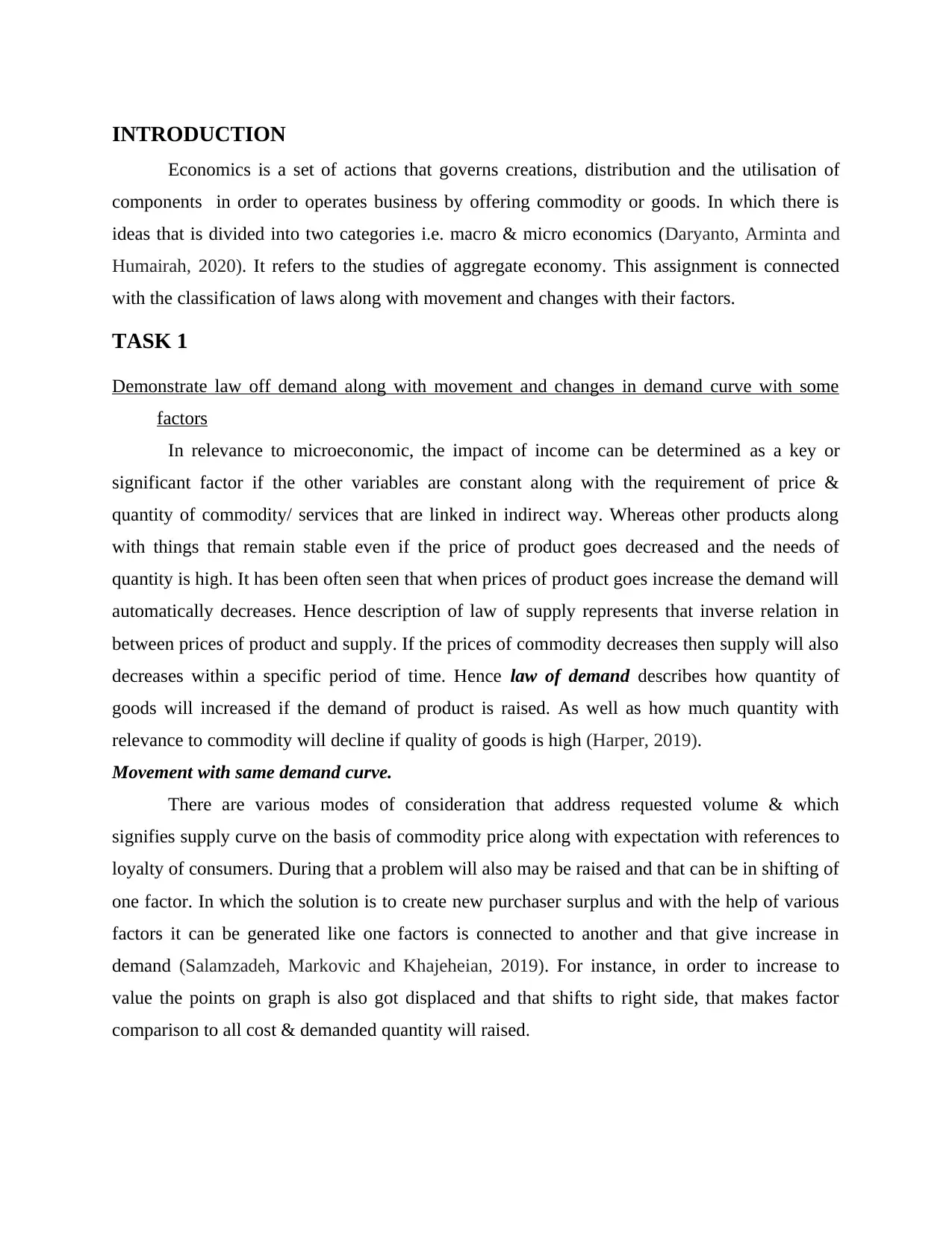
INTRODUCTION
Economics is a set of actions that governs creations, distribution and the utilisation of
components in order to operates business by offering commodity or goods. In which there is
ideas that is divided into two categories i.e. macro & micro economics (Daryanto, Arminta and
Humairah, 2020). It refers to the studies of aggregate economy. This assignment is connected
with the classification of laws along with movement and changes with their factors.
TASK 1
Demonstrate law off demand along with movement and changes in demand curve with some
factors
In relevance to microeconomic, the impact of income can be determined as a key or
significant factor if the other variables are constant along with the requirement of price &
quantity of commodity/ services that are linked in indirect way. Whereas other products along
with things that remain stable even if the price of product goes decreased and the needs of
quantity is high. It has been often seen that when prices of product goes increase the demand will
automatically decreases. Hence description of law of supply represents that inverse relation in
between prices of product and supply. If the prices of commodity decreases then supply will also
decreases within a specific period of time. Hence law of demand describes how quantity of
goods will increased if the demand of product is raised. As well as how much quantity with
relevance to commodity will decline if quality of goods is high (Harper, 2019).
Movement with same demand curve.
There are various modes of consideration that address requested volume & which
signifies supply curve on the basis of commodity price along with expectation with references to
loyalty of consumers. During that a problem will also may be raised and that can be in shifting of
one factor. In which the solution is to create new purchaser surplus and with the help of various
factors it can be generated like one factors is connected to another and that give increase in
demand (Salamzadeh, Markovic and Khajeheian, 2019). For instance, in order to increase to
value the points on graph is also got displaced and that shifts to right side, that makes factor
comparison to all cost & demanded quantity will raised.
Economics is a set of actions that governs creations, distribution and the utilisation of
components in order to operates business by offering commodity or goods. In which there is
ideas that is divided into two categories i.e. macro & micro economics (Daryanto, Arminta and
Humairah, 2020). It refers to the studies of aggregate economy. This assignment is connected
with the classification of laws along with movement and changes with their factors.
TASK 1
Demonstrate law off demand along with movement and changes in demand curve with some
factors
In relevance to microeconomic, the impact of income can be determined as a key or
significant factor if the other variables are constant along with the requirement of price &
quantity of commodity/ services that are linked in indirect way. Whereas other products along
with things that remain stable even if the price of product goes decreased and the needs of
quantity is high. It has been often seen that when prices of product goes increase the demand will
automatically decreases. Hence description of law of supply represents that inverse relation in
between prices of product and supply. If the prices of commodity decreases then supply will also
decreases within a specific period of time. Hence law of demand describes how quantity of
goods will increased if the demand of product is raised. As well as how much quantity with
relevance to commodity will decline if quality of goods is high (Harper, 2019).
Movement with same demand curve.
There are various modes of consideration that address requested volume & which
signifies supply curve on the basis of commodity price along with expectation with references to
loyalty of consumers. During that a problem will also may be raised and that can be in shifting of
one factor. In which the solution is to create new purchaser surplus and with the help of various
factors it can be generated like one factors is connected to another and that give increase in
demand (Salamzadeh, Markovic and Khajeheian, 2019). For instance, in order to increase to
value the points on graph is also got displaced and that shifts to right side, that makes factor
comparison to all cost & demanded quantity will raised.
⊘ This is a preview!⊘
Do you want full access?
Subscribe today to unlock all pages.

Trusted by 1+ million students worldwide
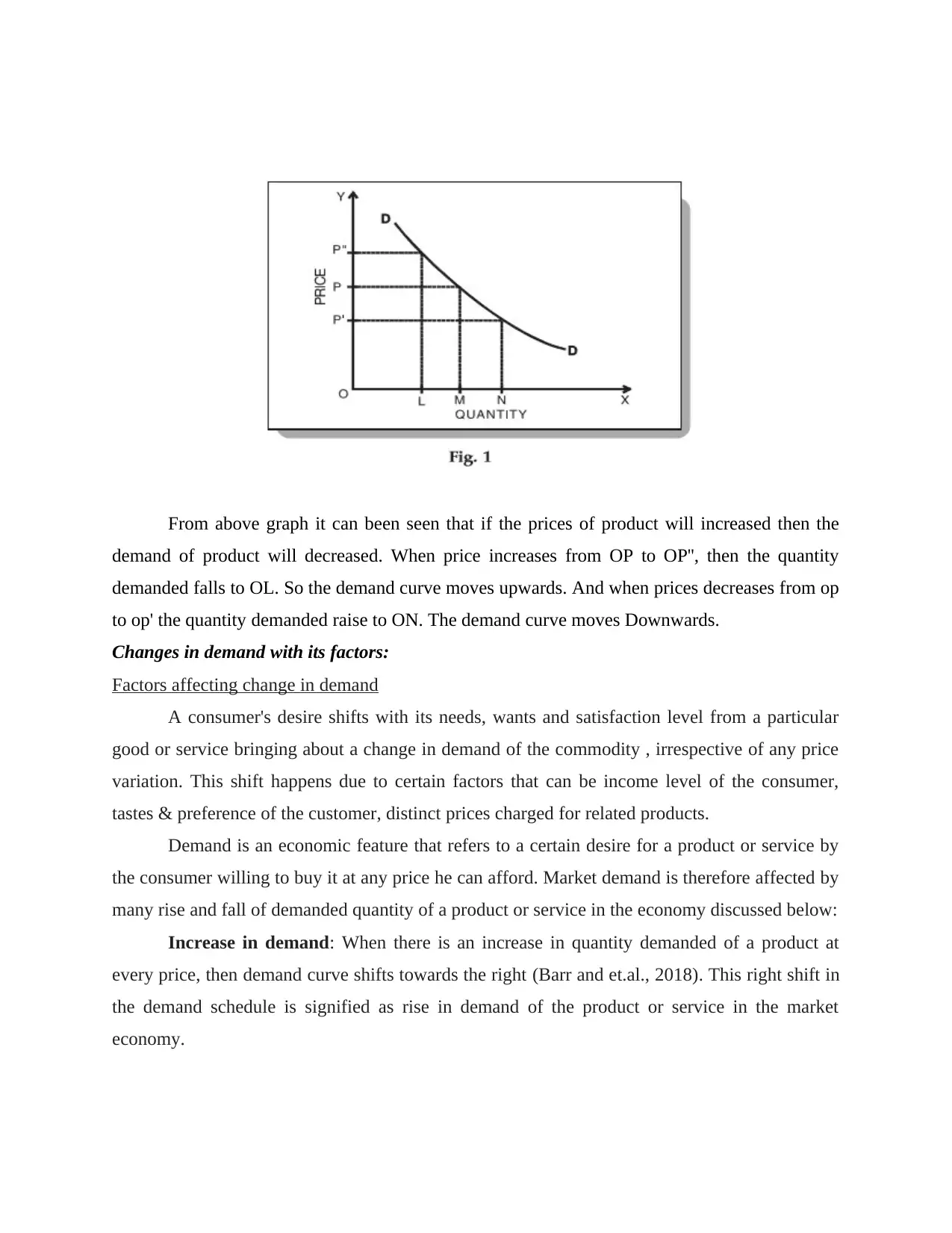
From above graph it can been seen that if the prices of product will increased then the
demand of product will decreased. When price increases from OP to OP'', then the quantity
demanded falls to OL. So the demand curve moves upwards. And when prices decreases from op
to op' the quantity demanded raise to ON. The demand curve moves Downwards.
Changes in demand with its factors:
Factors affecting change in demand
A consumer's desire shifts with its needs, wants and satisfaction level from a particular
good or service bringing about a change in demand of the commodity , irrespective of any price
variation. This shift happens due to certain factors that can be income level of the consumer,
tastes & preference of the customer, distinct prices charged for related products.
Demand is an economic feature that refers to a certain desire for a product or service by
the consumer willing to buy it at any price he can afford. Market demand is therefore affected by
many rise and fall of demanded quantity of a product or service in the economy discussed below:
Increase in demand: When there is an increase in quantity demanded of a product at
every price, then demand curve shifts towards the right (Barr and et.al., 2018). This right shift in
the demand schedule is signified as rise in demand of the product or service in the market
economy.
demand of product will decreased. When price increases from OP to OP'', then the quantity
demanded falls to OL. So the demand curve moves upwards. And when prices decreases from op
to op' the quantity demanded raise to ON. The demand curve moves Downwards.
Changes in demand with its factors:
Factors affecting change in demand
A consumer's desire shifts with its needs, wants and satisfaction level from a particular
good or service bringing about a change in demand of the commodity , irrespective of any price
variation. This shift happens due to certain factors that can be income level of the consumer,
tastes & preference of the customer, distinct prices charged for related products.
Demand is an economic feature that refers to a certain desire for a product or service by
the consumer willing to buy it at any price he can afford. Market demand is therefore affected by
many rise and fall of demanded quantity of a product or service in the economy discussed below:
Increase in demand: When there is an increase in quantity demanded of a product at
every price, then demand curve shifts towards the right (Barr and et.al., 2018). This right shift in
the demand schedule is signified as rise in demand of the product or service in the market
economy.
Paraphrase This Document
Need a fresh take? Get an instant paraphrase of this document with our AI Paraphraser
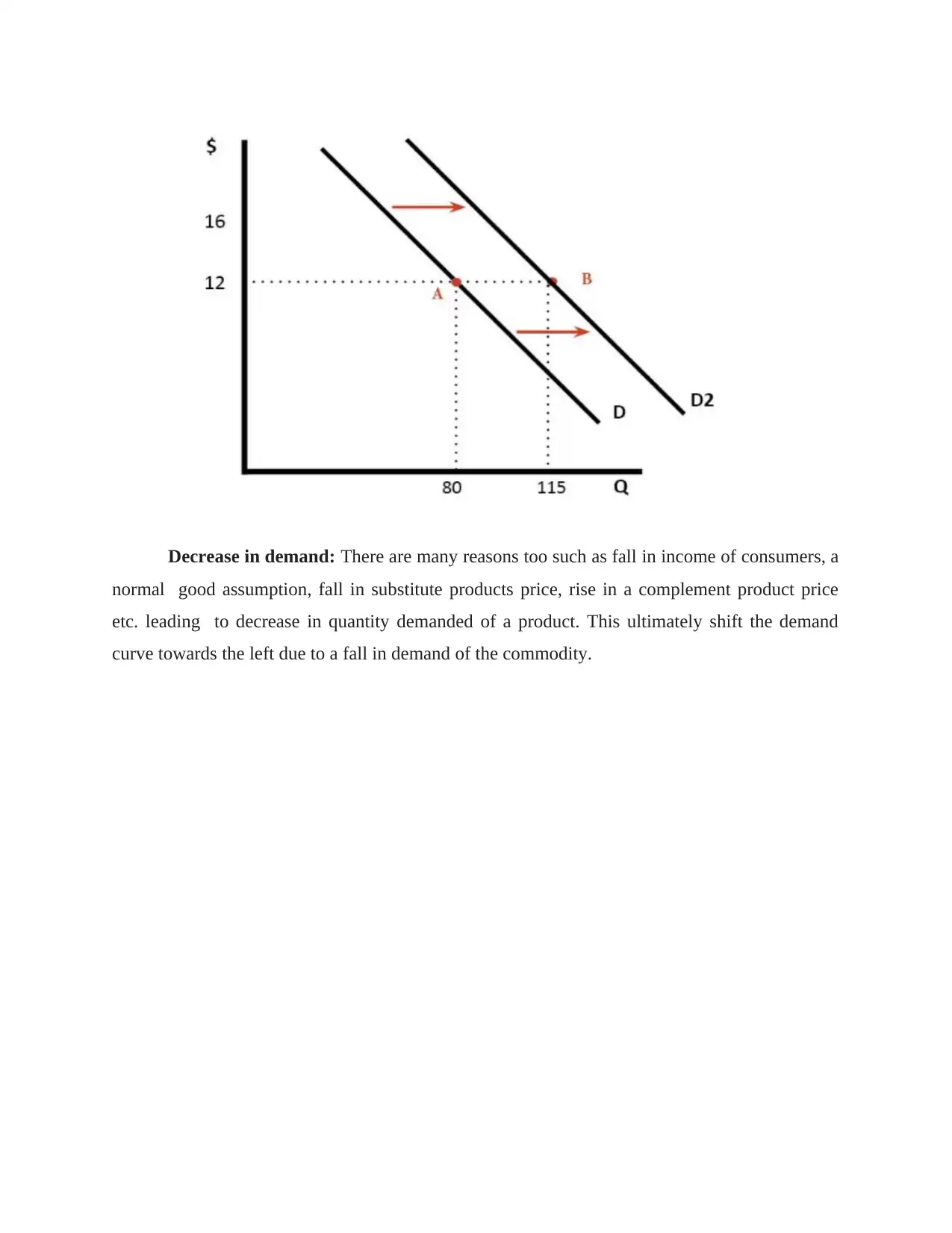
Decrease in demand: There are many reasons too such as fall in income of consumers, a
normal good assumption, fall in substitute products price, rise in a complement product price
etc. leading to decrease in quantity demanded of a product. This ultimately shift the demand
curve towards the left due to a fall in demand of the commodity.
normal good assumption, fall in substitute products price, rise in a complement product price
etc. leading to decrease in quantity demanded of a product. This ultimately shift the demand
curve towards the left due to a fall in demand of the commodity.
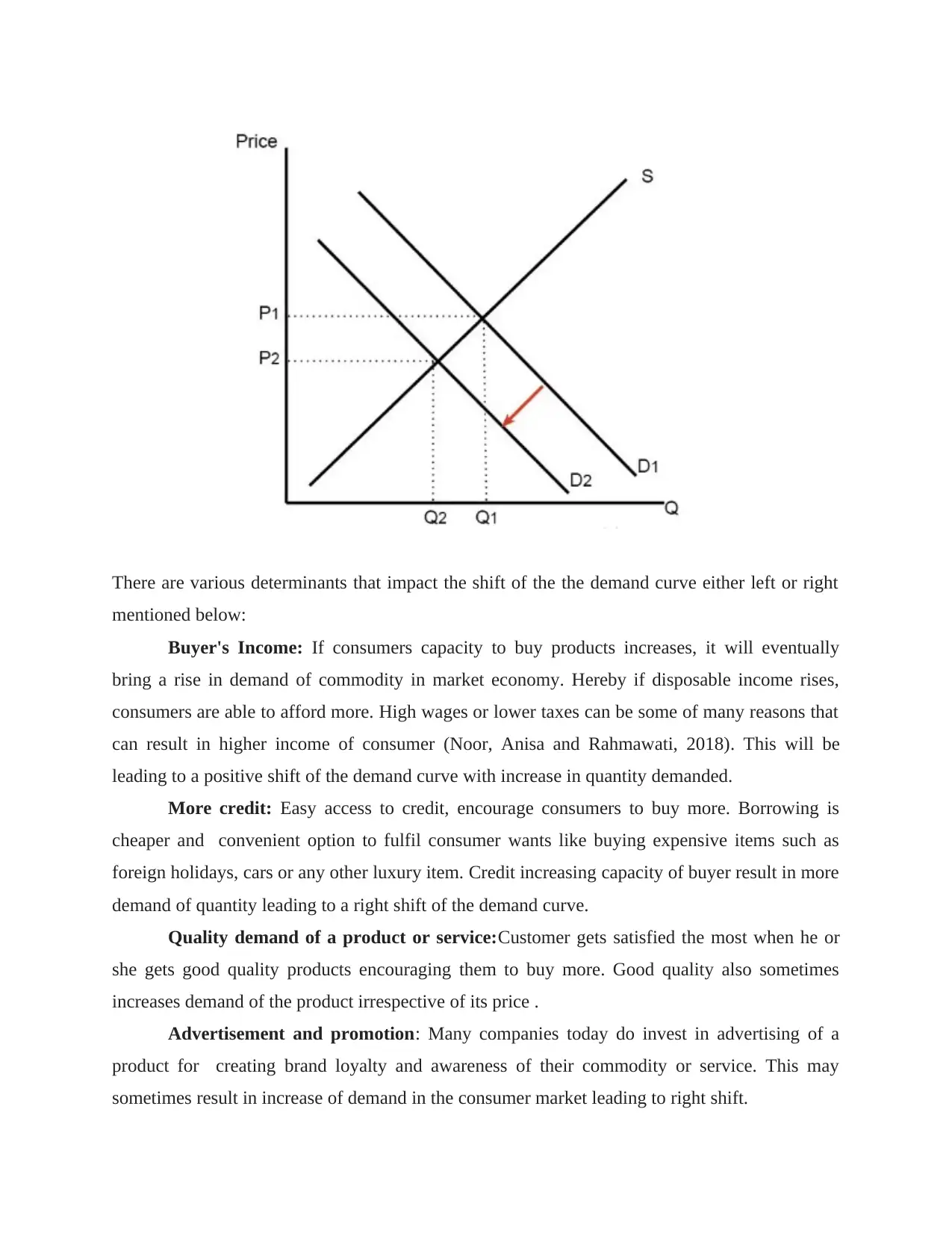
There are various determinants that impact the shift of the the demand curve either left or right
mentioned below:
Buyer's Income: If consumers capacity to buy products increases, it will eventually
bring a rise in demand of commodity in market economy. Hereby if disposable income rises,
consumers are able to afford more. High wages or lower taxes can be some of many reasons that
can result in higher income of consumer (Noor, Anisa and Rahmawati, 2018). This will be
leading to a positive shift of the demand curve with increase in quantity demanded.
More credit: Easy access to credit, encourage consumers to buy more. Borrowing is
cheaper and convenient option to fulfil consumer wants like buying expensive items such as
foreign holidays, cars or any other luxury item. Credit increasing capacity of buyer result in more
demand of quantity leading to a right shift of the demand curve.
Quality demand of a product or service:Customer gets satisfied the most when he or
she gets good quality products encouraging them to buy more. Good quality also sometimes
increases demand of the product irrespective of its price .
Advertisement and promotion: Many companies today do invest in advertising of a
product for creating brand loyalty and awareness of their commodity or service. This may
sometimes result in increase of demand in the consumer market leading to right shift.
mentioned below:
Buyer's Income: If consumers capacity to buy products increases, it will eventually
bring a rise in demand of commodity in market economy. Hereby if disposable income rises,
consumers are able to afford more. High wages or lower taxes can be some of many reasons that
can result in higher income of consumer (Noor, Anisa and Rahmawati, 2018). This will be
leading to a positive shift of the demand curve with increase in quantity demanded.
More credit: Easy access to credit, encourage consumers to buy more. Borrowing is
cheaper and convenient option to fulfil consumer wants like buying expensive items such as
foreign holidays, cars or any other luxury item. Credit increasing capacity of buyer result in more
demand of quantity leading to a right shift of the demand curve.
Quality demand of a product or service:Customer gets satisfied the most when he or
she gets good quality products encouraging them to buy more. Good quality also sometimes
increases demand of the product irrespective of its price .
Advertisement and promotion: Many companies today do invest in advertising of a
product for creating brand loyalty and awareness of their commodity or service. This may
sometimes result in increase of demand in the consumer market leading to right shift.
⊘ This is a preview!⊘
Do you want full access?
Subscribe today to unlock all pages.

Trusted by 1+ million students worldwide
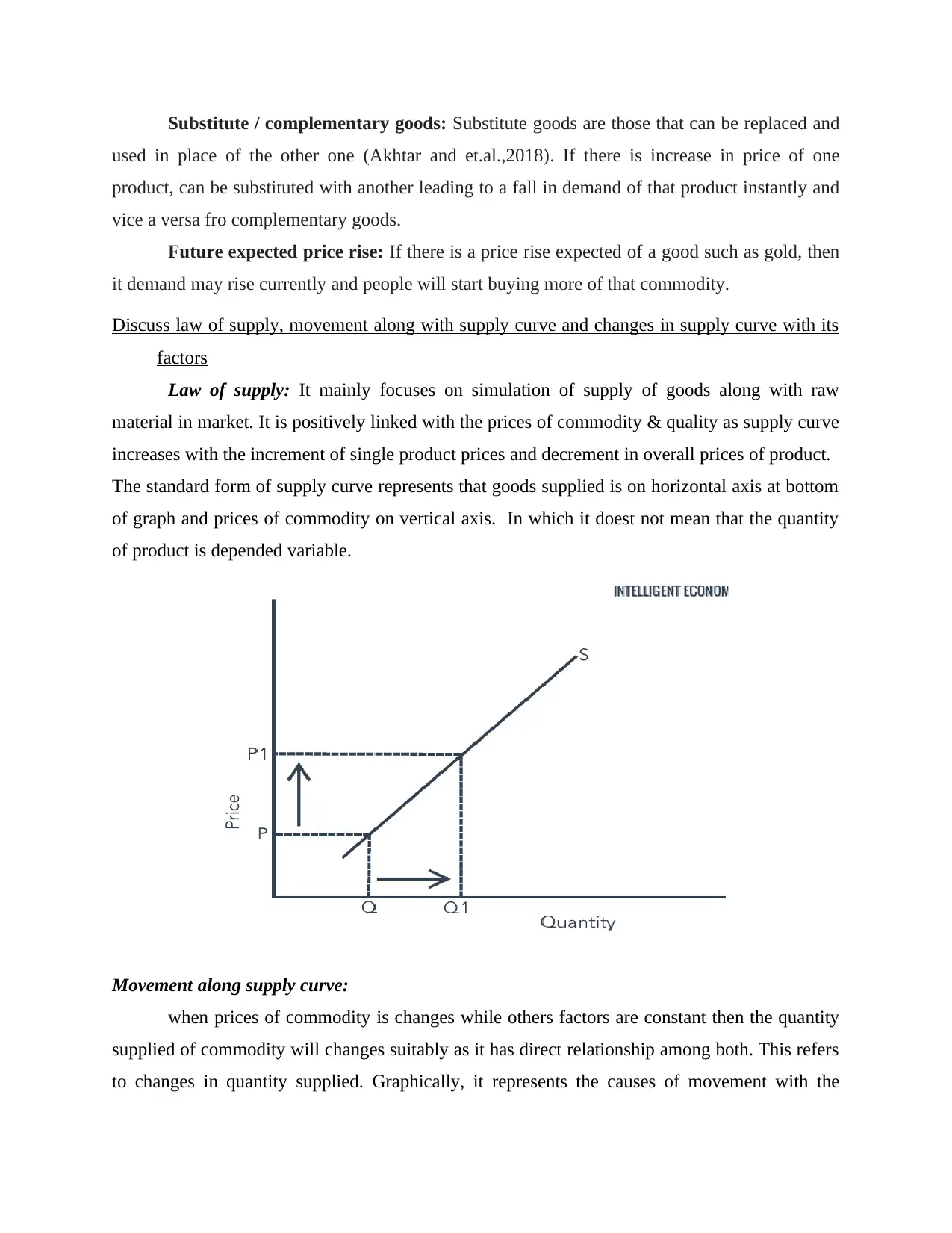
Substitute / complementary goods: Substitute goods are those that can be replaced and
used in place of the other one (Akhtar and et.al.,2018). If there is increase in price of one
product, can be substituted with another leading to a fall in demand of that product instantly and
vice a versa fro complementary goods.
Future expected price rise: If there is a price rise expected of a good such as gold, then
it demand may rise currently and people will start buying more of that commodity.
Discuss law of supply, movement along with supply curve and changes in supply curve with its
factors
Law of supply: It mainly focuses on simulation of supply of goods along with raw
material in market. It is positively linked with the prices of commodity & quality as supply curve
increases with the increment of single product prices and decrement in overall prices of product.
The standard form of supply curve represents that goods supplied is on horizontal axis at bottom
of graph and prices of commodity on vertical axis. In which it doest not mean that the quantity
of product is depended variable.
Movement along supply curve:
when prices of commodity is changes while others factors are constant then the quantity
supplied of commodity will changes suitably as it has direct relationship among both. This refers
to changes in quantity supplied. Graphically, it represents the causes of movement with the
used in place of the other one (Akhtar and et.al.,2018). If there is increase in price of one
product, can be substituted with another leading to a fall in demand of that product instantly and
vice a versa fro complementary goods.
Future expected price rise: If there is a price rise expected of a good such as gold, then
it demand may rise currently and people will start buying more of that commodity.
Discuss law of supply, movement along with supply curve and changes in supply curve with its
factors
Law of supply: It mainly focuses on simulation of supply of goods along with raw
material in market. It is positively linked with the prices of commodity & quality as supply curve
increases with the increment of single product prices and decrement in overall prices of product.
The standard form of supply curve represents that goods supplied is on horizontal axis at bottom
of graph and prices of commodity on vertical axis. In which it doest not mean that the quantity
of product is depended variable.
Movement along supply curve:
when prices of commodity is changes while others factors are constant then the quantity
supplied of commodity will changes suitably as it has direct relationship among both. This refers
to changes in quantity supplied. Graphically, it represents the causes of movement with the
Paraphrase This Document
Need a fresh take? Get an instant paraphrase of this document with our AI Paraphraser
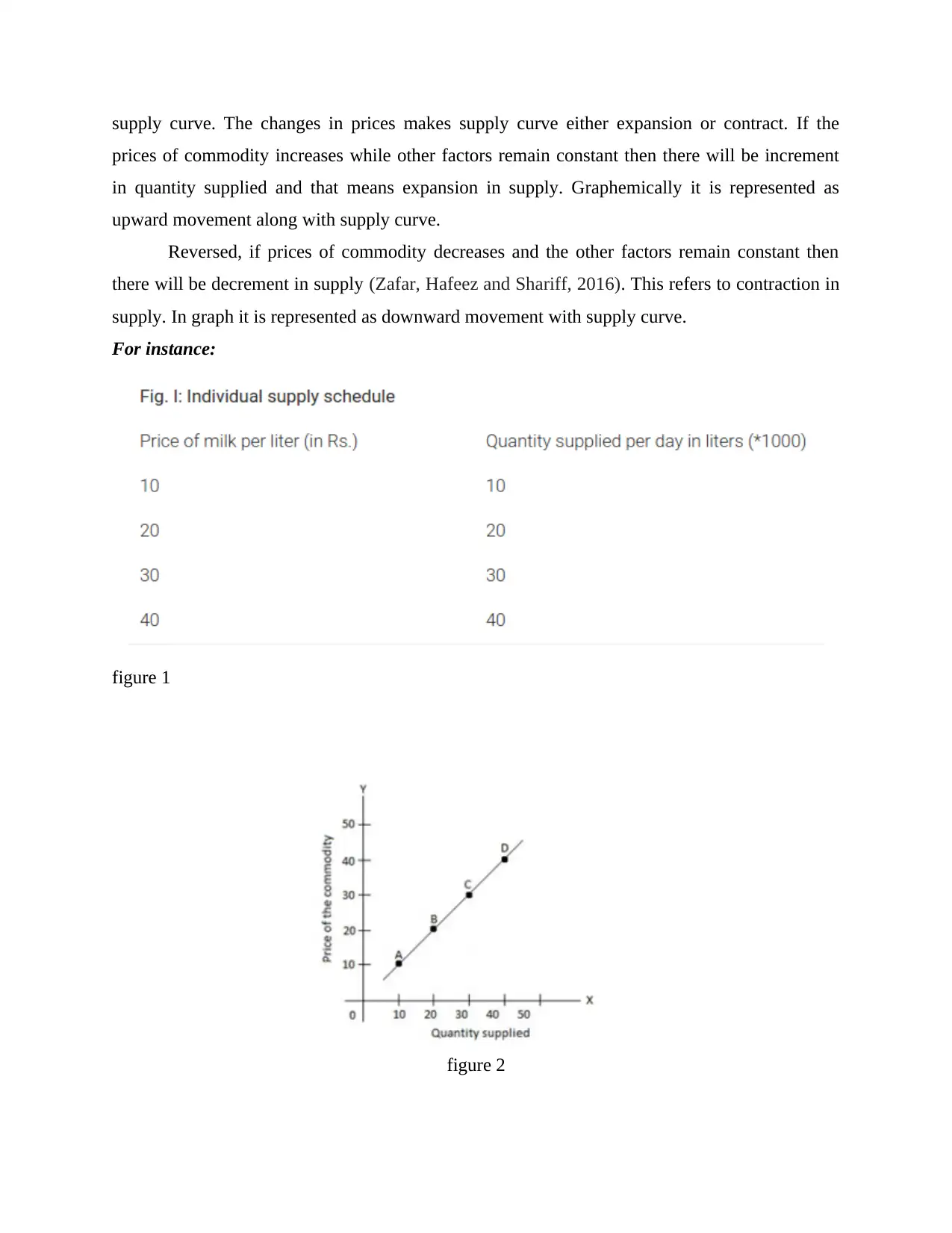
supply curve. The changes in prices makes supply curve either expansion or contract. If the
prices of commodity increases while other factors remain constant then there will be increment
in quantity supplied and that means expansion in supply. Graphemically it is represented as
upward movement along with supply curve.
Reversed, if prices of commodity decreases and the other factors remain constant then
there will be decrement in supply (Zafar, Hafeez and Shariff, 2016). This refers to contraction in
supply. In graph it is represented as downward movement with supply curve.
For instance:
figure 1
figure 2
prices of commodity increases while other factors remain constant then there will be increment
in quantity supplied and that means expansion in supply. Graphemically it is represented as
upward movement along with supply curve.
Reversed, if prices of commodity decreases and the other factors remain constant then
there will be decrement in supply (Zafar, Hafeez and Shariff, 2016). This refers to contraction in
supply. In graph it is represented as downward movement with supply curve.
For instance:
figure 1
figure 2
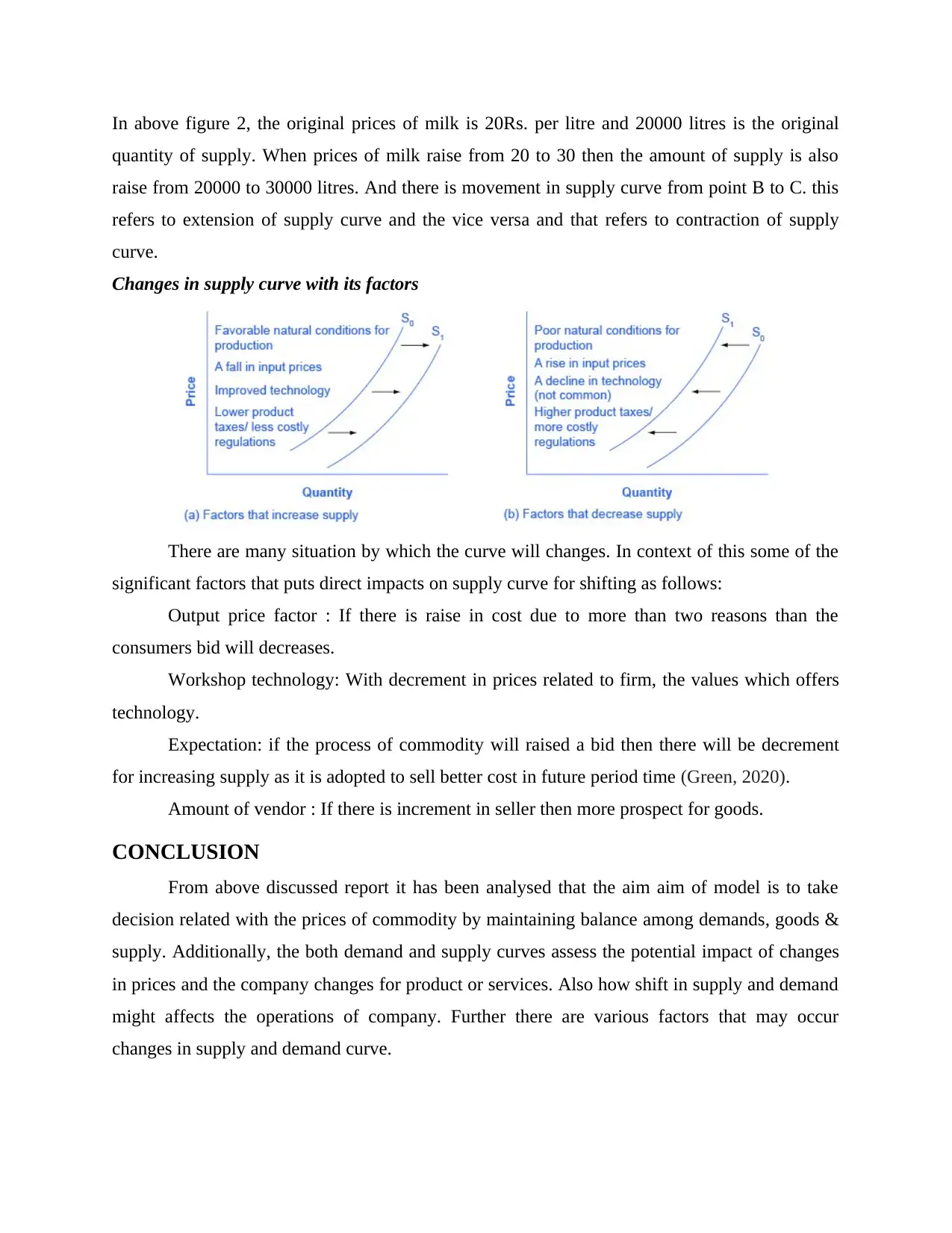
In above figure 2, the original prices of milk is 20Rs. per litre and 20000 litres is the original
quantity of supply. When prices of milk raise from 20 to 30 then the amount of supply is also
raise from 20000 to 30000 litres. And there is movement in supply curve from point B to C. this
refers to extension of supply curve and the vice versa and that refers to contraction of supply
curve.
Changes in supply curve with its factors
There are many situation by which the curve will changes. In context of this some of the
significant factors that puts direct impacts on supply curve for shifting as follows:
Output price factor : If there is raise in cost due to more than two reasons than the
consumers bid will decreases.
Workshop technology: With decrement in prices related to firm, the values which offers
technology.
Expectation: if the process of commodity will raised a bid then there will be decrement
for increasing supply as it is adopted to sell better cost in future period time (Green, 2020).
Amount of vendor : If there is increment in seller then more prospect for goods.
CONCLUSION
From above discussed report it has been analysed that the aim aim of model is to take
decision related with the prices of commodity by maintaining balance among demands, goods &
supply. Additionally, the both demand and supply curves assess the potential impact of changes
in prices and the company changes for product or services. Also how shift in supply and demand
might affects the operations of company. Further there are various factors that may occur
changes in supply and demand curve.
quantity of supply. When prices of milk raise from 20 to 30 then the amount of supply is also
raise from 20000 to 30000 litres. And there is movement in supply curve from point B to C. this
refers to extension of supply curve and the vice versa and that refers to contraction of supply
curve.
Changes in supply curve with its factors
There are many situation by which the curve will changes. In context of this some of the
significant factors that puts direct impacts on supply curve for shifting as follows:
Output price factor : If there is raise in cost due to more than two reasons than the
consumers bid will decreases.
Workshop technology: With decrement in prices related to firm, the values which offers
technology.
Expectation: if the process of commodity will raised a bid then there will be decrement
for increasing supply as it is adopted to sell better cost in future period time (Green, 2020).
Amount of vendor : If there is increment in seller then more prospect for goods.
CONCLUSION
From above discussed report it has been analysed that the aim aim of model is to take
decision related with the prices of commodity by maintaining balance among demands, goods &
supply. Additionally, the both demand and supply curves assess the potential impact of changes
in prices and the company changes for product or services. Also how shift in supply and demand
might affects the operations of company. Further there are various factors that may occur
changes in supply and demand curve.
⊘ This is a preview!⊘
Do you want full access?
Subscribe today to unlock all pages.

Trusted by 1+ million students worldwide
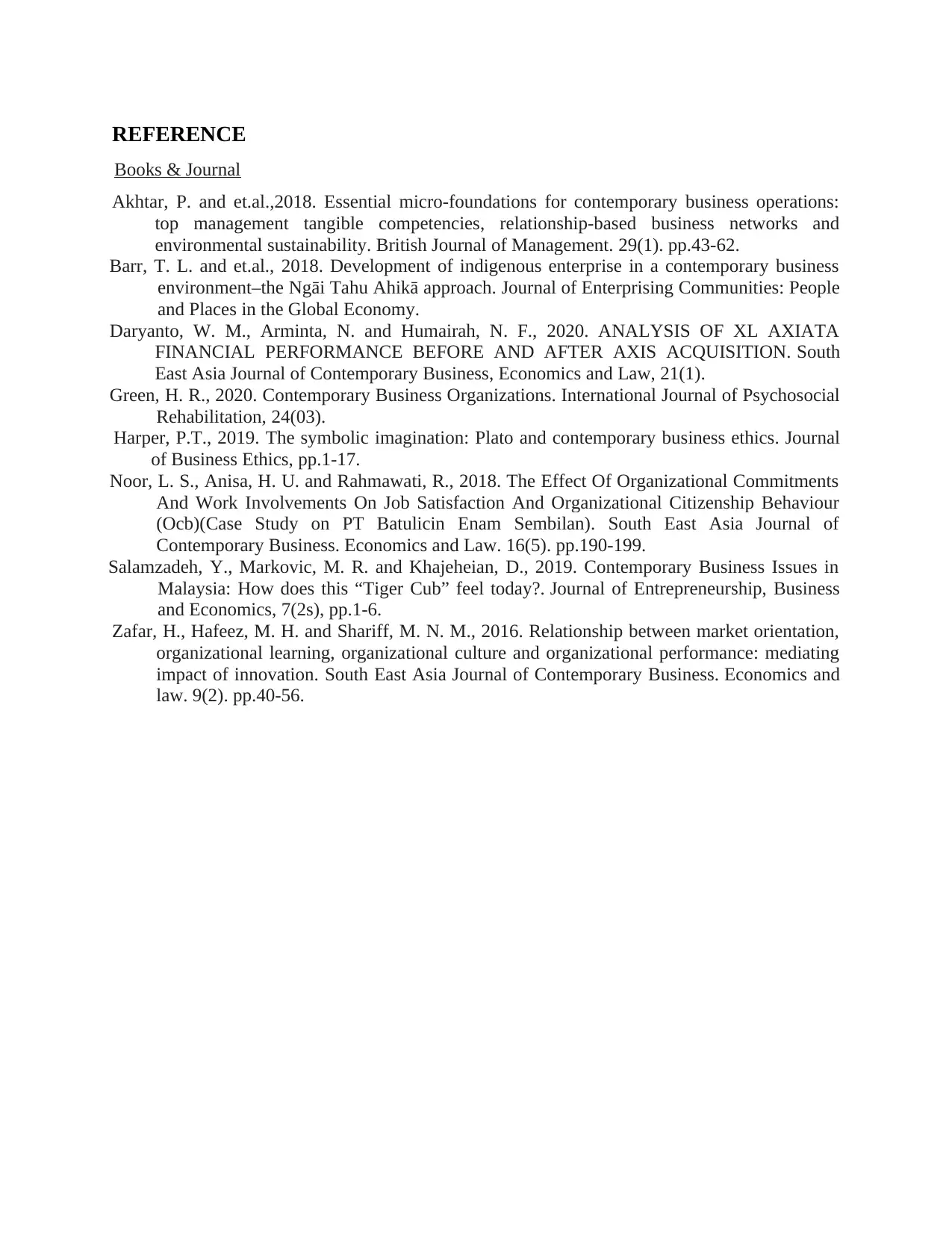
REFERENCE
Books & Journal
Akhtar, P. and et.al.,2018. Essential micro‐foundations for contemporary business operations:
top management tangible competencies, relationship‐based business networks and
environmental sustainability. British Journal of Management. 29(1). pp.43-62.
Barr, T. L. and et.al., 2018. Development of indigenous enterprise in a contemporary business
environment–the Ngāi Tahu Ahikā approach. Journal of Enterprising Communities: People
and Places in the Global Economy.
Daryanto, W. M., Arminta, N. and Humairah, N. F., 2020. ANALYSIS OF XL AXIATA
FINANCIAL PERFORMANCE BEFORE AND AFTER AXIS ACQUISITION. South
East Asia Journal of Contemporary Business, Economics and Law, 21(1).
Green, H. R., 2020. Contemporary Business Organizations. International Journal of Psychosocial
Rehabilitation, 24(03).
Harper, P.T., 2019. The symbolic imagination: Plato and contemporary business ethics. Journal
of Business Ethics, pp.1-17.
Noor, L. S., Anisa, H. U. and Rahmawati, R., 2018. The Effect Of Organizational Commitments
And Work Involvements On Job Satisfaction And Organizational Citizenship Behaviour
(Ocb)(Case Study on PT Batulicin Enam Sembilan). South East Asia Journal of
Contemporary Business. Economics and Law. 16(5). pp.190-199.
Salamzadeh, Y., Markovic, M. R. and Khajeheian, D., 2019. Contemporary Business Issues in
Malaysia: How does this “Tiger Cub” feel today?. Journal of Entrepreneurship, Business
and Economics, 7(2s), pp.1-6.
Zafar, H., Hafeez, M. H. and Shariff, M. N. M., 2016. Relationship between market orientation,
organizational learning, organizational culture and organizational performance: mediating
impact of innovation. South East Asia Journal of Contemporary Business. Economics and
law. 9(2). pp.40-56.
Books & Journal
Akhtar, P. and et.al.,2018. Essential micro‐foundations for contemporary business operations:
top management tangible competencies, relationship‐based business networks and
environmental sustainability. British Journal of Management. 29(1). pp.43-62.
Barr, T. L. and et.al., 2018. Development of indigenous enterprise in a contemporary business
environment–the Ngāi Tahu Ahikā approach. Journal of Enterprising Communities: People
and Places in the Global Economy.
Daryanto, W. M., Arminta, N. and Humairah, N. F., 2020. ANALYSIS OF XL AXIATA
FINANCIAL PERFORMANCE BEFORE AND AFTER AXIS ACQUISITION. South
East Asia Journal of Contemporary Business, Economics and Law, 21(1).
Green, H. R., 2020. Contemporary Business Organizations. International Journal of Psychosocial
Rehabilitation, 24(03).
Harper, P.T., 2019. The symbolic imagination: Plato and contemporary business ethics. Journal
of Business Ethics, pp.1-17.
Noor, L. S., Anisa, H. U. and Rahmawati, R., 2018. The Effect Of Organizational Commitments
And Work Involvements On Job Satisfaction And Organizational Citizenship Behaviour
(Ocb)(Case Study on PT Batulicin Enam Sembilan). South East Asia Journal of
Contemporary Business. Economics and Law. 16(5). pp.190-199.
Salamzadeh, Y., Markovic, M. R. and Khajeheian, D., 2019. Contemporary Business Issues in
Malaysia: How does this “Tiger Cub” feel today?. Journal of Entrepreneurship, Business
and Economics, 7(2s), pp.1-6.
Zafar, H., Hafeez, M. H. and Shariff, M. N. M., 2016. Relationship between market orientation,
organizational learning, organizational culture and organizational performance: mediating
impact of innovation. South East Asia Journal of Contemporary Business. Economics and
law. 9(2). pp.40-56.
1 out of 10
Related Documents
Your All-in-One AI-Powered Toolkit for Academic Success.
+13062052269
info@desklib.com
Available 24*7 on WhatsApp / Email
![[object Object]](/_next/static/media/star-bottom.7253800d.svg)
Unlock your academic potential
Copyright © 2020–2025 A2Z Services. All Rights Reserved. Developed and managed by ZUCOL.




